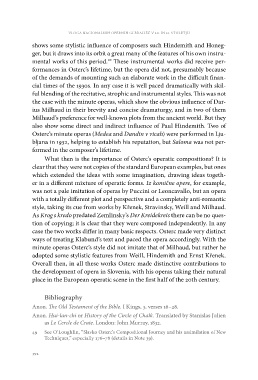Page 394 - Weiss, Jernej, ur. 2019. Vloga nacionalnih opernih gledališč v 20. in 21. stoletju - The Role of National Opera Houses in the 20th and 21st Centuries. Koper/Ljubljana: Založba Univerze na Primorskem in Festival Ljubljana. Studia musicologica Labacensia, 3
P. 394
vloga nacionalnih opernih gledališč v 20. in 21. stoletju
shows some stylistic influence of composers such Hindemith and Honeg-
ger, but it draws into its orbit a great many of the features of his own instru-
mental works of this period.49 These instrumental works did receive per-
formances in Osterc’s lifetime, but the opera did not, presumably because
of the demands of mounting such an elaborate work in the difficult finan-
cial times of the 1930s. In any case it is well paced dramatically with skil-
ful blending of the recitative, strophic and instrumental styles. This was not
the case with the minute operas, which show the obvious influence of Dar-
ius Milhaud in their brevity and concise dramaturgy, and in two of them
Milhaud’s preference for well-known plots from the ancient world. But they
also show some direct and indirect influence of Paul Hindemith. Two of
Osterc’s minute operas (Medea and Dandin v vicah) were performed in Lju-
bljana in 1932, helping to establish his reputation, but Saloma was not per-
formed in the composer’s lifetime.
What then is the importance of Osterc’s operatic compositions? It is
clear that they were not copies of the standard European examples, but ones
which extended the ideas with some imagination, drawing ideas togeth-
er in a different mixture of operatic forms. Iz komične opere, for example,
was not a pale imitation of operas by Puccini or Leoncavallo, but an opera
with a totally different plot and perspective and a completely anti-romantic
style, taking its cue from works by Křenek, Stravinsky, Weill and Milhaud.
As Krog s kredo predated Zemlinsky’s Der Kreidekreis there can be no ques-
tion of copying; it is clear that they were composed independently. In any
case the two works differ in many basic respects. Osterc made very distinct
ways of treating Klabund’s text and paced the opera accordingly. With the
minute operas Osterc’s style did not imitate that of Milhaud, but rather he
adopted some stylistic features from Weill, Hindemith and Ernst Křenek.
Overall then, in all these works Osterc made distinctive contributions to
the development of opera in Slovenia, with his operas taking their natural
place in the European operatic scene in the first half of the 20th century.
Bibliography
Anon. The Old Testament of the Bible. I Kings, 3, verses 16–28.
Anon. Hui-lan-chi or History of the Circle of Chalk. Translated by Stanislas Julien
as Le Cercle de Craie. London: John Murray, 1832.
49 See O’Loughlin, “Slavko Osterc’s Compositional Journey and his assimilation of New
Techniques,” especially 176–78 (details in Note 39).
392
shows some stylistic influence of composers such Hindemith and Honeg-
ger, but it draws into its orbit a great many of the features of his own instru-
mental works of this period.49 These instrumental works did receive per-
formances in Osterc’s lifetime, but the opera did not, presumably because
of the demands of mounting such an elaborate work in the difficult finan-
cial times of the 1930s. In any case it is well paced dramatically with skil-
ful blending of the recitative, strophic and instrumental styles. This was not
the case with the minute operas, which show the obvious influence of Dar-
ius Milhaud in their brevity and concise dramaturgy, and in two of them
Milhaud’s preference for well-known plots from the ancient world. But they
also show some direct and indirect influence of Paul Hindemith. Two of
Osterc’s minute operas (Medea and Dandin v vicah) were performed in Lju-
bljana in 1932, helping to establish his reputation, but Saloma was not per-
formed in the composer’s lifetime.
What then is the importance of Osterc’s operatic compositions? It is
clear that they were not copies of the standard European examples, but ones
which extended the ideas with some imagination, drawing ideas togeth-
er in a different mixture of operatic forms. Iz komične opere, for example,
was not a pale imitation of operas by Puccini or Leoncavallo, but an opera
with a totally different plot and perspective and a completely anti-romantic
style, taking its cue from works by Křenek, Stravinsky, Weill and Milhaud.
As Krog s kredo predated Zemlinsky’s Der Kreidekreis there can be no ques-
tion of copying; it is clear that they were composed independently. In any
case the two works differ in many basic respects. Osterc made very distinct
ways of treating Klabund’s text and paced the opera accordingly. With the
minute operas Osterc’s style did not imitate that of Milhaud, but rather he
adopted some stylistic features from Weill, Hindemith and Ernst Křenek.
Overall then, in all these works Osterc made distinctive contributions to
the development of opera in Slovenia, with his operas taking their natural
place in the European operatic scene in the first half of the 20th century.
Bibliography
Anon. The Old Testament of the Bible. I Kings, 3, verses 16–28.
Anon. Hui-lan-chi or History of the Circle of Chalk. Translated by Stanislas Julien
as Le Cercle de Craie. London: John Murray, 1832.
49 See O’Loughlin, “Slavko Osterc’s Compositional Journey and his assimilation of New
Techniques,” especially 176–78 (details in Note 39).
392


